You can read all the posts about this particular junction, in order, here.
You know, writing about the Leeds-Bradford “Cycle Superhighway” can be really difficult, because the information provided by the people running the scheme is so often poor and inconsistent.
Last year I wrote about being confused by the plans, which were full of mistakes and essentially unreadable. It was impossible to know what was intended due to the lack of detail provided and mistakes in the plans.
And that hasn’t changed, the plans provided are still too vague. So if I’m going to make my points about the now-infamous junction, dear reader, I must first explain some errors in the plans. Here goes…
Some hypothetical junctions, and some green blobs
The information provided by the PR people defines four types of junction, as you can see in the image below. Each type has an icon.

Note that none of these resemble the finished product. (Original PDF here.)
Even though these icons are meant to simplify things, they’re used so inconsistently that they might as well have not bothered.
Below are the four icons as shown on the plans in question. Note the cycle lane and cycle track icons have been switched, and that there’s a different icon for raised table:
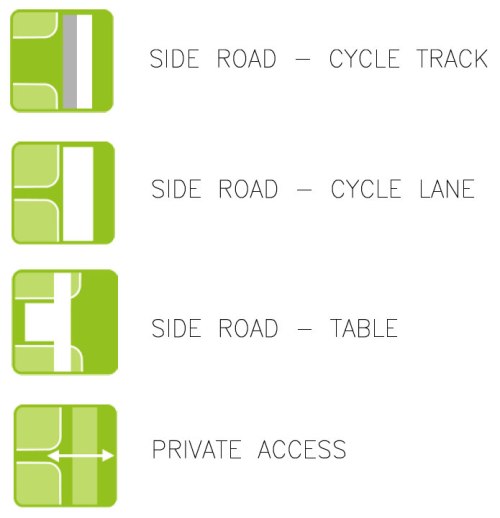
Only one of these actually matches the image above. Does anyone have any aspirin? (Original PDF here.)
Okay, fine, there are confusing green blobs. Get on with it!
Anyway this is a long and boring way of saying that according to the design, the junction of Dick Lane and Grange Avenue should look like this:
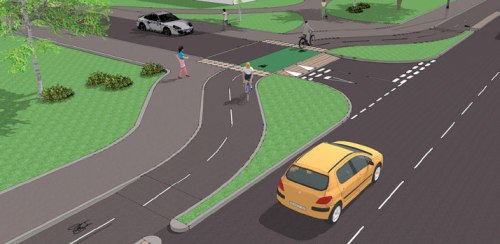
And not like this:

Though I think we now know where the silly wiggle came from. It seems it’s an amateurish and foolish attempt to shrink down the example junction into the space available.
The example junction in the diagram isn’t actually too bad. There’s a few mistakes (the narrow cycleway, the cycleway curve and ramp are too sharp, the visual priority is poor, there’s no need for the tactiles, there’s no continuous footway) but it’s generally the right idea. There’s actually a British example of this with good visual priority (though no footway) and a not-quite-as-good example here. You can watch a Dutch version in action here.
It’s a good design, because it allows turning cars to deal with crossing the cycleway separately, in two distinct steps. It also gives people on bikes time to react to a turning vehicle if necessary, as they’re not riding right alongside the turning car. It also means that cars being driven out of the side road don’t block the cycleway while they wait for a gap in traffic on the main road.
Lost in space
But there’s clearly no space for that here! Well, there is space – tons of it, as you can see from above:
A lane could be removed from the gyratory (shock!) or the main road could be moved west to create space for a wider cycleway and proper junction treatment.
But I can hear the excuses already: there’s not enough money in the budget to do that, it would mean moving utilities, we’d have to cut down a tree, it will reduce the almighty motor capacity, and so on.
But if that’s the case, then why did CityConnect specify that type of junction here, where it clearly doesn’t fit within the space given? I suspect that’s the only bi-directional junction they had in their toolbox, so it was simply slapped on here without much thought.
So, let’s see what we can do within the current space.
No more complaining, here’s some suggestions…
Bear in mind, this option is compromised: the cycleway is already far too narrow, and two-way cycleways need to be designed with care to mitigate the additional risks they present at junctions.
A better option would be to make this cycleway one-way, and have the northbound cycleway on the west side of Dick Lane (as suggested by Jitensha Oni on Twitter). There’s certainly enough room between the carriageway and the park wall. I think that would be a better option, as it reduces the number of interactions on the east side.
But whether this happened or not, there are two things that could be done to improve matters:
• Make Grange Avenue (the side road) one-way, therefore becoming ‘no entry’ at this junction, or even removing the junction altogether.
• Give the cycleway and footway visual priority across this junction by using contrasting materials.
I can’t see a reason why Grange Avenue is a two-way through route, as it just connects back to the main road around the corner anyway. I’d suggest simply blocking it off altogether at this junction. Or, if it must remain open for some reason, it could be arranged like this (my suggestion in red):
If Grange Avenue was made a one-way street then people on foot and bike only have to worry about motor vehicles approaching from one direction. (At the moment, a 270° view is required when cycling southbound!)
More detail, please!
Okay, let’s do our best under the circumstances. It might look like this:

I’ll shout this: THIS IS NOT MY IDEAL DESIGN! THIS IS STILL FLAWED! Please read below…
The footway and cycleway should be surfaced in materials which contrast with the carriageway, to give clear visual priority to the footway and cycleway.
The footway will ideally be a light colour, using light paving slabs (reinforced to handle the weight of motor vehicles, of course) and the cycleway should be surfaced in red asphalt (specifically, machine-laid red 55/10 HRA).
Ideally the entire cycleway should be in red asphalt, but unfortunately black has already been used. So as we’re dealing with a remedial fix here, the surfacing must extend along the footway and carriageway beyond the junction in both directions for several metres in order to provide the visual priority required.
The footway and cycleway need to be at footway height across the junction – i.e. with an ‘upstand’ of around 12.5cm.
To achieve this, as the cycleway approaches the junction, it will need to very gently rise up, over several metres so it’s barely perceptible, until it becomes level with the footway for a few metres before and after the junction.
At the junction, therefore, motor vehicles will need to climb a ramp to mount the crossover area, then descend a ramp into the main carriageway on the other side.
A cycle symbol and an arrow should be painted on the cycleway where it crosses the junction. (Assuming the cycleway is still bi-directional, there will need to be one in each direction.)
Finally, a “STOP” line and sign could be placed before the ramp at the end of Grange Avenue, to reinforce the footway and cycleway priority.
The finished thing might look vaguely like this (use a little imagination):

I’ve flipped this so it makes more sense to UK eyes. (Photo: Google Maps)
The design is still not ideal, though the main problem now is that the cycleway is far too narrow to be bi-directional – making it one way, would be preferable. But either way we’ve solved the left-hook problem and made priority very clear.
Unfortunately, unless a lane is removed or the road is shifted, there isn’t enough space for a car exiting Grange Avenue to wait beyond the cycleway and footway, which will mean that it would occasionally be blocked by a car waiting for a break in traffic on Dick Lane.
Note that this actually looks a lot like CityConnect’s other design for where a cycleway crosses a junction, albeit much improved.
Now about my fee…
99 bottles of beer on the wall…
The frustrating thing is, this is just one junction out of hundreds, maybe even thousands, on the CityConnect project. How many more have been dangerously designed, or changed without notice?
I’ve been informed about several dodgy bits by concerned people in Leeds, and I’ve spotted many more on the plans that are either vague (just like this one was, pre-installation) or look like they’ll be very fiddly by bike (think multiple toucans and 90º turns).
It’s exhausting looking through all the information around just this one junction, so I do appreciate the scale of the work involved, and the time and effort that local cycle campaigners must have put in when reviewing the plans.
But, in some locations at least, the finished infrastructure is still far from good enough. Perhaps it’s due to the way the project was funded – a limited amount of money that has to be spent on a big scheme within a short time period. So the money was spread too thinly, and the plans were rushed. I don’t think we build motorways like that.
Or maybe it’s due to the lack of interest the local councils seem to have in the scheme now that the £18m cheque has cleared and the Tour de France has left town.
I’ve been told by several sources that people high up in Leeds City Council insisted that the “Cycle Superhighway” must not – under any circumstances – reduce motor vehicle capacity. That, apparently, is a red line that was not to be crossed.
What sort of attitude is that? It may be 2015 where you are, but it’s still 1970 in certain rooms inside Leeds Town Hall.
Under constraints like that, I can see why at least some of the route is turning out to be disappointing, and I do have some sympathy for the people behind the scheme as they try to achieve big plans with so little time, money and support from above.
Not all of it is bad, some sections do look pretty promising, and I’d genuinely love to see photos and videos of the good bits too. But the problems do need fixing – the junction featured here is a real howler. If there hadn’t been an outcry about this one junction, who knows how many times this awful design might have been repeated throughout the route?
As public money is being spent on this project, it’s only fair to scrutinise it in public too. If the conclusion is that central government’s bizarre funding restrictions doomed the project from the start, or that the council is choking bits of it to death, then this should be acknowledged rather than letting the PR department pretend everything is fine. This isn’t a witch-hunt, I just think the public deserves to know what went wrong, and why.
Still to come, one day: the canal towpath of doom, and a huge junction full of toucan crossings.

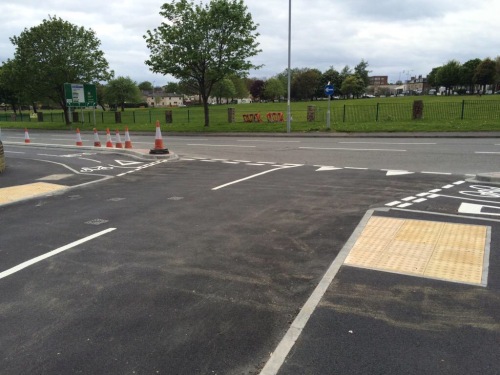






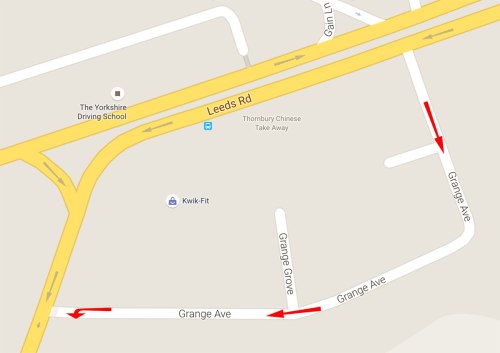




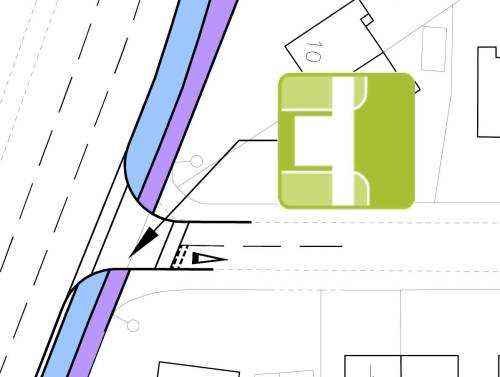
 The Alternative Department for Transport is written by, and the personal opinion of,
The Alternative Department for Transport is written by, and the personal opinion of, 


